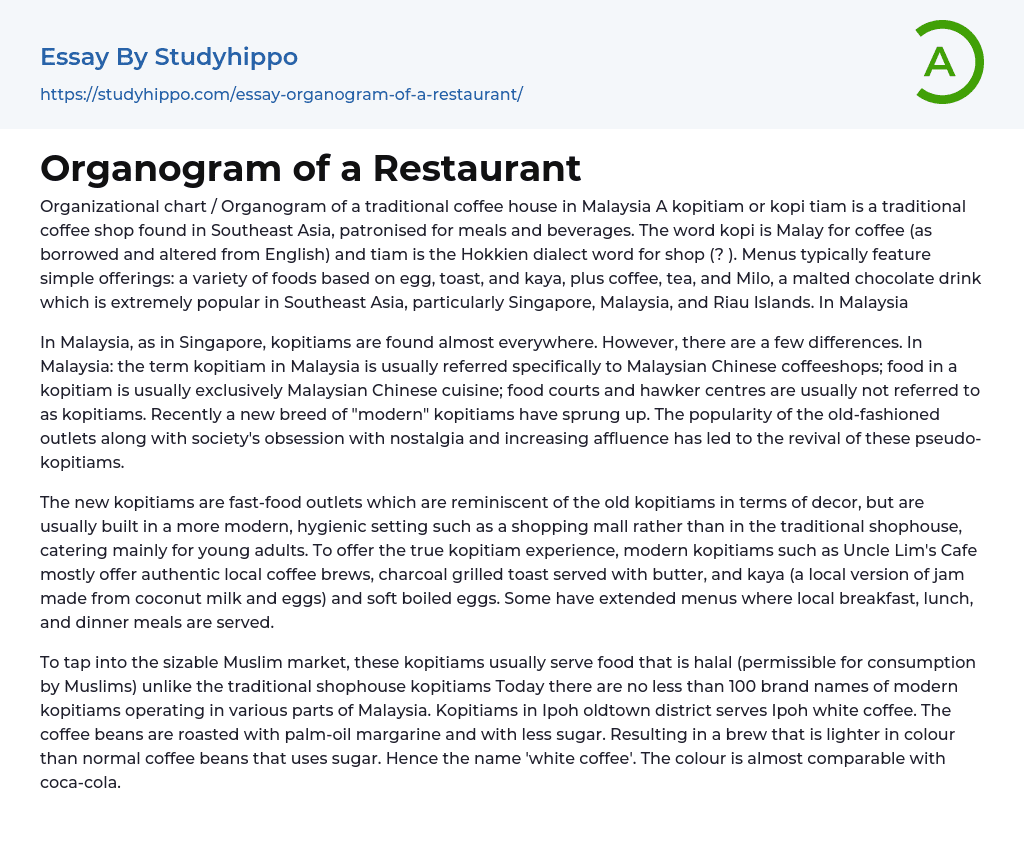Organizational chart / Organogram of a traditional coffee house in Malaysia A kopitiam or kopi tiam is a traditional coffee shop found in Southeast Asia, patronised for meals and beverages. The word kopi is Malay for coffee (as borrowed and altered from English) and tiam is the Hokkien dialect word for shop (? ). Menus typically feature simple offerings: a variety of foods based on egg, toast, and kaya, plus coffee, tea, and Milo, a malted chocolate drink which is extremely popular in Southeast Asia, particularly Singapore, Malaysia, and Riau Islands. In Malaysia
In Malaysia, as in Singapore, kopitiams are found almost everywhere. However, there are a few differences. In Malaysia: the term kopitiam in Malaysia is usually referred specifically to Malaysian Chinese coffeeshops; food in a kopitiam is usually exclusively Malaysian Ch
...inese cuisine; food courts and hawker centres are usually not referred to as kopitiams. Recently a new breed of "modern" kopitiams have sprung up. The popularity of the old-fashioned outlets along with society's obsession with nostalgia and increasing affluence has led to the revival of these pseudo-kopitiams.
The new kopitiams are fast-food outlets which are reminiscent of the old kopitiams in terms of decor, but are usually built in a more modern, hygienic setting such as a shopping mall rather than in the traditional shophouse, catering mainly for young adults. To offer the true kopitiam experience, modern kopitiams such as Uncle Lim's Cafe mostly offer authentic local coffee brews, charcoal grilled toast served with butter, and kaya (a local version of jam made from coconut milk and eggs) and soft boiled eggs. Some have extended menus where local breakfast,
lunch, and dinner meals are served.
To tap into the sizable Muslim market, these kopitiams usually serve food that is halal (permissible for consumption by Muslims) unlike the traditional shophouse kopitiams Today there are no less than 100 brand names of modern kopitiams operating in various parts of Malaysia. Kopitiams in Ipoh oldtown district serves Ipoh white coffee. The coffee beans are roasted with palm-oil margarine and with less sugar. Resulting in a brew that is lighter in colour than normal coffee beans that uses sugar. Hence the name 'white coffee'. The colour is almost comparable with coca-cola.
- Food essays
- Genetically Modified Organisms essays
- Child Development essays
- Eating essays
- Breakfast essays
- Genetically Modified Food essays
- Milk essays
- Chewing gum essays
- Energy Drink essays
- Caffeine essays
- Chocolate essays
- vegetarian essays
- Weight Loss essays
- Anorexia essays
- Metabolism essays
- Diet essays
- Vitamin essays
- Dieting essays
- Junk Food essays
- Eating Habits essays
- Food Safety essays
- Food Security essays
- Beverages essays
- Cuisines essays
- Dairy essays
- Desserts essays
- Fast Food essays
- Bread essays
- Meal essays
- Meat essays
- Organic Food essays
- Rice essays
- Sugar essays
- Taste essays
- Beef essays
- Coconut essays
- Crowd essays
- Dinner essays
- Juice essays
- Sainsbury essays
- Cooking essays
- Ginger essays
- Oreo essays
- Drink essays
- Beer essays
- Wine essays
- Coffee essays
- Tea essays
- Cake essays
- Hamburger essays




